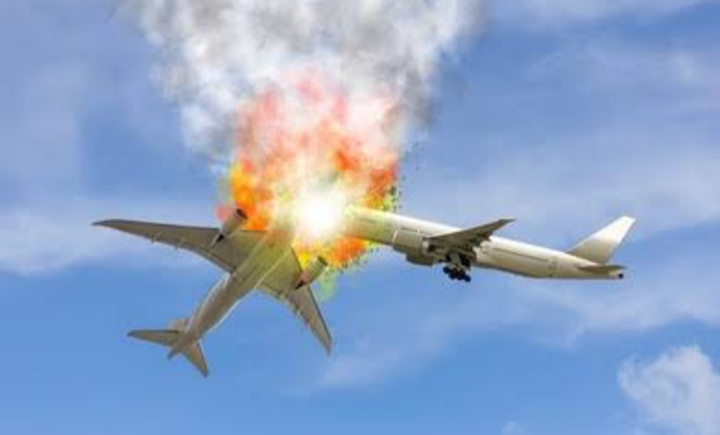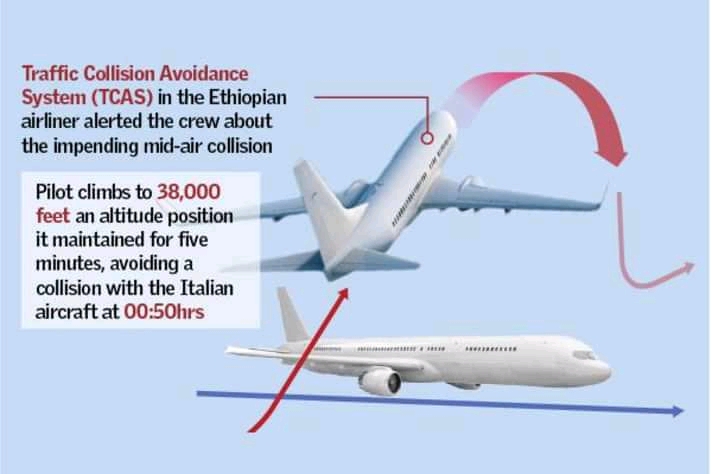Two passenger planes almost crashed mid air in Kenya last week August 2018. The two planes missed each other by just a minute. Had they crashed, the accident would have gone into record as one of the worst aviation accidents in history.
The planes involved belonged to Ethiopian Airlines and an Italian leisure airline.
The near accident which would have occurred in Naivasha was averted by the TCAS system that alerts pilots on an impending collision.
Apparently, after receiving caution from the inflight traffic collision system known as TCAS, one of the pilots made a sudden climb to avoid the oncoming plane.
On Wednesday August 29, 2018, the Ethiopian Airlines flight number ET858, a Boeing 737-800, registration number ET-ASJ left Johannesburg for Addis Ababa at 2100 hours. Its flight time was five hours, 12 minutes cruising at a calibrated altitude of 37,000 feet.”
“On the same day at 18:00 hours, an Italian leisure airline Neos Boeing 767-306R flight number NOS252, registration I-NDOF had left the Italian city of Verona heading to Zanzibar. Its flight time was eight hours before it made its first landing in Zanzibar.
At 00:49 hours, both aircraft were in Kenyan airspace, at the same altitude, with the Italian aircraft having entered from the Ethiopian airspace, while the Ethiopian Airlines from the Tanzania airspace. They were flying towards each other.
The TCAS Resolution Advisory alerted the Ethiopian airline crew about the impending mid-air collision and the pilot climbed to 38,000 feet in just one minute (at 00:50 hrs). He maintained the altitude for five minutes, avoiding a collision.
Following this shocking incident, Kenya and Ethiopia embarked on a blame game.
Kenya’s air traffic controllers appeared to be blaming the incident on a strike by Ethiopian air traffic controllers.
“The Italian airliner approached and entered the Kenyan airspace from the Westside using 370L but it wasn’t informed by the Ethiopian air control that an ET flight was also using the same altitude East side as it crossed over Kenya heading to Addis. This was a serious breach of safety,” a source in the Kenyan aviation had said.
The day after the near mishap, the Kenya Air Traffic Controllers’ Association warned that flights going into and out of the Addis Ababa airspace were not safe.
“We have seen some eastbound flights coming in with westbound flight levels while some westbound flights have eastbound levels, increasing chances of serious air misses,” the association had said.
The association further said that the Ethiopian traffic controllers had not provided proper standard separation in the incident.
“We saw flights from Addis Ababa calling the Nairobi Control without prior estimates, with the possibility of creating serious air-misses with known traffic at the transfer point given that they were entering our airspace with wrong levels,” the association said.
“This was the issue with the ET and Neos, which both maintained FL360 with no prior co-ordination and no estimates from Addis Ababa control. Were it not for the TCAS, the story would have been different.”
The Ethiopian Civil Aviation Authority (ECAA) rejected the Kenyan air controller’s claim, saying its control centre is manned by capable air traffic controllers, adding that the approach and aerodrome positions within its airspace are also manned with professionals possessing all the qualifications.
“We reject the false and baseless statements circulated by the Kenyan Air Traffickers Controllers Association. Our Area Control Centre in Addis Ababa is being manned by adequate number of well-trained, highly capable instructors and professionals with the necessary ratings and validations in accordance with International Civil Aviation Organisation Annex 1 provisions.”
Did you love the story? You can also share YOUR story and get it published on Bizna Click here to get started.





